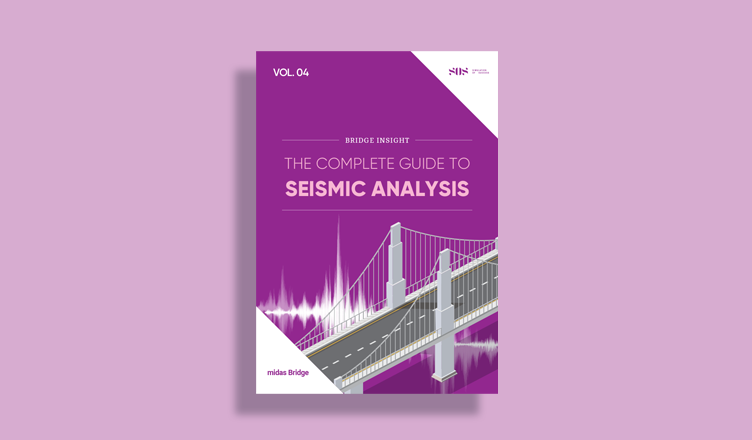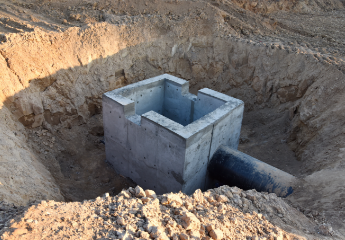Please fill out the Download Section (Click here) below the Comment Section to download the Complete Guide to Seismic Anlalysis
dfwefwfefwefwefwefew
wefwfewfwefwefwefwefwfwfe
*Click the content to move to the section
Response Spectrum Analysis
Earthquakes are a natural phenomenon that surprises us regardless of their scale. Earthquakes are a critical design condition that must be applied to all structures designed by engineers, including civil and architectural structures. In this content, we will summarize and consolidate an overseas MIDAS webinar on seismic simulations' key steps and non-linear time history analysis using midas Civil for seismic design.
Key Steps of Response Spectrum Analysis
To perform response spectrum analysis using midas Civil, the following processes are followed:
1. Boundary Condition Setup: Before initiating seismic analysis, the structure's boundary conditions must be defined. Typically, this is done using elastic links (soil springs) to describe the ground behavior. These are generally defined as Elastic Links, accounting for vertical and lateral stiffness. The elasticity boundary, considering the ground's characteristics, utilizes the Elastic Link, which is a 1D element. Defining the local axis is crucial when specifying its characteristics.
Generally, the Elastic Link for describing the ground is modeled in the vertical direction (Global Axis). Consequently, the length direction "X" of the 1D element becomes vertically stiff based on the local axis of the 1D element. Lateral stiffness is applied in the "Y" and "Z" directions.
2. Model Definition: The target structure should be modeled using appropriate element types. Additionally, the loads specified by design criteria, including self-weight, additional loads, and live loads, are applied for seismic analysis.
3. Response Spectrum Definition: According to design criteria, response spectra are calculated by considering the target region's ground conditions and seismic conditions. While various coefficients are needed for response spectrum calculation, utilizing the response spectrum data provided by midas Civil simplifies the generation of proposed response spectra from various countries.
4. Eigenvalue Analysis: To understand the structure's inherent vibration characteristics, eigenvalue analysis must be conducted. This mode analysis is also referred to as eigenvalue analysis and is performed to analyze the ground/structure's inherent dynamic characteristics. The inherent characteristics refer to the essential qualities of the structure in a free vibration state unaffected by external stimuli. Generally, they are determined by the structure's mass and stiffness. Midas Civil automatically includes eigenvalue analysis in the seismic analysis process.
5. Application of Response Spectrum: The response spectrum defined in step 3 is applied to the structure, considering the direction of seismic action, to simulate its impact on the structure.
6. Analysis of Correlation between Earthquake and Structure: A simulation adjustment process involves confirming the vibration characteristics of the structure (eigenvalue analysis results) and the resonance of the response spectrum. Correlation factors are applied to the spectral acceleration to reflect non-linear effects.
7. Result Verification: Seismic analysis yields information on forces, moments, stresses, and deformations vital for structural safety. By applying design criteria, the structural safety can be reviewed.
In midas Civil, analysis results can be viewed in both text and Excel formats (tables). Additionally, the contour feature facilitates the intuitive visualization of calculated results, enabling the identification of areas with concentrated loads and locations with significant deformations.
Non-Linear Time History Analysis
Non-linear time history analysis is conducted to account for non-linear behavior in structures under varying loads over time, such as seismic loads. This analysis aims to understand the non-linear behavior of structures under dynamic load conditions, such as earthquakes, by analyzing the response of structures subjected to changing external loads, including seismic loads. To address structural non-linearity, material non-linearity, geometric non-linearity, and non-linearity of loads and boundaries must be considered.
In midas Civil, the non-linear behavior of ground and civil structures can be considered in time history analysis. Similar to non-linear static analysis, material non-linearity, geometric non-linearity, and non-linearity of loads and boundaries can all be considered collectively or selectively for analysis. Generally, since most ground exhibits material non-linearity, accurate simulation of ground response can be achieved through non-linear time history analysis.
This type of non-linear time history analysis is especially useful for seismic analysis, incorporating the structure's non-linear behavior under seismic forces for more realistic results. Typically, non-linear time history analysis follows the steps outlined below:
1. Generation of Seismic Waves: Seismic waves over time must be generated. These waves can be generated using measured data or by applying response spectra proposed by design criteria. Midas Civil provides a library of various seismic waves observed worldwide, facilitating convenient wave generation.
2. Application of Seismic Waves: The generated artificial seismic waves are applied to the model to perform non-linear time history analysis. Using midas Civil, artificial seismic waves are applied to the structure according to their direction of action, and the results are analyzed.
3. Visualization of Analysis Results: Visualization of analysis results allows the observation of structural deformations, forces, stresses, etc. Animation displays the changing behavior of the structure after an earthquake over time. The visualization demonstrates how the structure's deformation progresses due to increased external forces.
4. Linear Analysis Transformation: Non-linear behavior of surface elements can be transformed into linear analysis to estimate effective stiffness and damping and conduct linear spectrum analysis.
Thus, the essential steps of seismic calculations and non-linear time history analysis have been explored. The content can be further demonstrated and understood through the provided webinar.
Seismic calculations are a crucial phase in designing safe structures, and non-linear time history analysis improves the accurate modeling of real seismic situations. Through such calculations, it is hoped that the construction of safe and robust structures will be facilitated. Thank you!
Please fill out the Download Section (Click here) below the Comment Section to download the Complete Guide to Seismic Anlalysis
 Get Started midas Civil
Get Started midas Civil
 Featured blog of this week
Featured blog of this week









